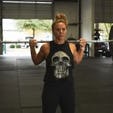There’s one thing nerds and meatheads will always have in common—they both want to be superheroes. Whether you’re a longtime gym rat or not, if you grew up reading comic books or watching action movies, you wished you could have had sleeve-ripping arms like Wolverine, the athleticism of Captain America, strength like Thor, etc.
Well, now you can. Or as close as you can get without undergoing genetic mutation, government experiments, or divine intervention. Introducing our Superhero Workout series—fitness tips, exercises, and routines designed to transform you from a mere civilian into the defender of the planet you knew you were always meant to be. Check back here all week for plans to acquire your favorite superhero’s particular skill or attribute, which we’ll bring you one at a time.
Today, we offer a blueprint to rebuild your body like Tony Stark did to become Ironman.
The Iron Man Workout

Just because you have an aching shoulder, a bad back, or haven’t been in a gym since Robert Downey Jr. was last arrested, you can still forge a strong, heroic physique. Sam Pogue, Onnit Academy’s Director of Communications and one of its senior coaches, recommends using kettlebells on your journey back to action.
“They point out where your technique is failing in your exercises,” says Pogue, who says that improper form is either the source of training-related injuries in the first place or greatly aggravates them over time. Because the weight displacement in a kettlebell makes it so difficult to stabilize, your body must maintain near-perfect alignment in any movement you perform in order to execute it properly—and if it doesn’t, you’ll know right away.
If you’re not training around an injury but simply trying to get back in shape, kettlebells build an awesome foundation of strength and stability that will transfer to any fitness goal or implement you choose to train with.
Pogue suggests adding the following exercises to your workouts, which he conveniently modeled for you below.
1. Weighted Carry
Grasp two evenly-weighted kettlebells by their handles. Hold one in the rack position—under your chin with your forearm vertical and shoulders drawn back and down (think “proud chest”). Hold the other at arm’s length at your side. Keep your torso vertical with a rigid core.
Walk 30 to 40 yards at a slow cadence—heel to toe and under total control. Repeat for 3 to 5 sets, switching the kettlebell positions each set. “When your grip gets tired,” says Pogue, “stop.”
“Maintaining your shoulder position—not letting your scaps get pulled forward by the weight—reinforces the integrity of the muscles that encapsulate the shoulder,” says Pogue. This helps to rehab shoulder pain and prevent future damage. “And what better way to train total-body stability than by moving in a posture we find ourselves in every day? Walking.”
2. Half-Kneeling Bottoms-Up Press
Get into a lunge position and rest your back knee on the floor. Hold a kettlebell in the rack position (described above) by its handle upside down, so that its bell faces the ceiling. Keeping your torso vertical and your “proud chest” position, press the weight straight overhead. Keep your ribs down.
Take four seconds to lift the weight and four to lower it again, actively pulling it down to your shoulder so you feel your lats turn on, as if you were doing a pullup.
Perform 5 reps to lockout, or, if you can’t lock it out without falling out of position, press only as high as you can and perform a static hold for time. Rest as needed, switch sides, and repeat for 3 sets each side, noting the total amount of time you were able to hold the weight for. Beat that time in your next session.
“Even holding the kettlebell in the bottom of the rack position, if that’s all you can manage, can build the stability needed to press overhead in a full range safely,” says Pogue. Again, the kettlebell provides amazing feedback on your form. “It will fall over if you lose position.”
3. Half-Turkish Getup
Lie on your back on the floor holding a kettlebell with your right hand over your chest, arm perpendicular to the floor. Bend your right knee 90 degrees and plant your foot on the floor. Brace your abs and raise your torso off the floor. Use your left hand for support. Now use your right foot to raise your hips off the floor. Sweep your left leg back and rest on your left knee.
Reverse the motion to return to the floor. Note that the foot that rests on the floor changes with the hand that’s holding the weight (when you perform the getup with the left hand your left foot will lie flat). Perform 5 reps on each side.
This move works great as a warmup before a workout of any kind, activating your core and stability throughout the body. “The getup opens up tight shoulders and trains your abs without aggravating your lumbar,” says Pogue, which conventional ab moves like situps and crunches will, if you have a pre-existing lower-back injury.

)





